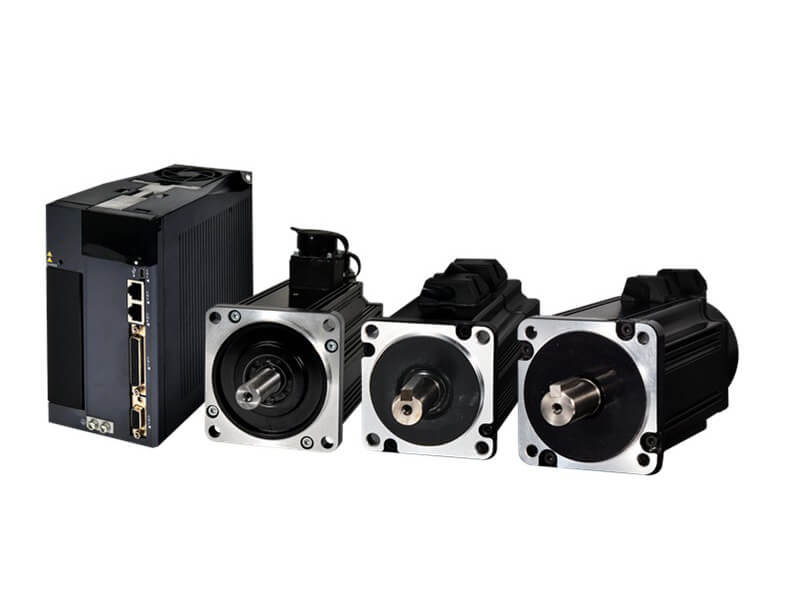What is the difference between servo and stepper motor?
Stepper motor principle.
As a special motor for control, a stepper motor is an actuator that converts electrical pulses into angular displacement. When the stepper driver receives a pulse signal, it drives the stepper motor to rotate a fixed angle (called “step angle”) in the set direction, and its rotation is run step by step with a fixed step angle. The number of pulses can be controlled to control the amount of angular displacement, so as to achieve the purpose of accurate positioning; at the same time, the pulse frequency can be controlled to control the speed and acceleration of motor rotation, so as to achieve the purpose of speed regulation, change the winding energizing sequence, the motor will reverse.
Driver principle Stepper motor needs to be driven by a special stepper motor driver, which consists of pulse generation control unit, power drive unit, protection unit, etc. The power drive unit amplifies the pulse generated by the pulse generation control unit and couples directly with the stepper motor, which belongs to the power interface between the stepper motor and the microcontroller.
The control command unit, receives the pulse and direction signals, and the corresponding pulse generation control unit generates a set of pulses of corresponding phase number, which is sent to the stepper motor after the power drive unit, and the stepper motor turns through a step angle in the corresponding direction. The pulse giving mode of the driver determines the stepper motor operation as follows.
(1) m-phase single m-beat operation
(2) m-phase double m-beat operation
(3) m-phase single and double m-beat operation
(4) subdivision drive, the driver needs to give different amplitude drive signal stepper motor has some important technical data, such as ** static torque, starting frequency, running frequency, etc..
Generally speaking, the smaller the step angle, the greater the motor ** static torque, the higher the starting frequency and running frequency, so the operating mode emphasizes the subdivision drive technology, which improves the stepper motor’s rotational torque and resolution, and completely eliminates the motor’s low-frequency oscillation. So the interpolation drive drive performance is superior to other types of drives.
The rotor inside the servo motor is a permanent magnet, and the U/V/W three-phase electricity controlled by the drive forms an electromagnetic field, and the rotor rotates under the action of this magnetic field, while the motor comes with an encoder feedback signal to the drive, and the drive compares the feedback value with the target value to adjust the angle of rotor rotation.
Servo motor principle
Servo motor, also known as an actuator motor, is used as an actuating element in an automatic control system to convert the electrical signal received into an angular displacement or angular velocity output on the motor shaft. There are two types of servo motors: DC and AC servo motors.
Servo motor receives 1 pulse, it will rotate the angle corresponding to 1 pulse, so as to realize the displacement, because, the servo motor itself has the function of sending out pulses, so the servo motor will send out the corresponding number of pulses for every rotation angle, so that, and the pulses received by the servo motor form a closed loop, the system will know how many pulses sent to the servo motor, and at the same time, how many pulses received back, so that it will be able to control the rotation of the motor very precisely, thus achieving precise positioning.
In the performance comparison, AC servo motor is better than DC servo motor. AC servo motor adopts sine wave control, the torque pulsation is small, and the capacity can be relatively large. DC servo motor adopts trapezoidal wave control, which is relatively poor.
DC servo motor brushless servo motor than brush servo motor to performance to be better. Servo motor driver servo motor internal rotor is a permanent magnet, the driver control U/V/W three-phase electricity to form an electromagnetic field, the rotor rotates under the action of this magnetic field, while the motor comes with an encoder feedback signal to the driver, the driver according to the feedback value and the target value for comparison, adjust the rotor rotation angle.
Brushed DC servo motor drive: The motor works exactly the same as an ordinary DC motor, and the drive is a three-closed-loop structure, from the inside to the outside of the current loop, speed loop and position loop respectively. The output of the current loop controls the armature voltage of the motor, the input of the current loop is the output of the speed loop PID, the input of the speed loop is the PID output of the position loop, the input of the position loop is the given input, the control principle diagram is shown above.
Brushless DC servo motor drive: the power supply is DC, through the internal three-phase inverter inverted into U/V/W AC power, supply the motor, the drive also uses three closed-loop control structure (current loop, speed loop, position loop), the drive control principle is the same as above.
AC servo motor driver: it can be roughly divided into two modules with relatively independent functions: power board and control board. The control board outputs PWM signal through the corresponding algorithm as the drive signal of the drive circuit to change the output power of the inverter to control the three-phase permanent magnet synchronous AC servo motor.
The power drive unit first rectifies the input three-phase power or utility power through the three-phase full-bridge rectifier circuit to get the corresponding DC power. After the rectified three-phase power or utility power, then through the three-phase sinusoidal PWM voltage inverter frequency conversion to drive three-phase permanent magnet synchronous AC servo motor, simply said is the AC-DC-AC variable current process. The control unit is the core of the whole AC servo system, which realizes the system position control, speed control, torque and current control.
Servo and stepper motor performance comparison
Control accuracy: the more phases and beats of the stepper motor, the higher its accuracy, servo motor take the block with the encoder, the more the encoder scale, the higher the accuracy;
Low-frequency characteristics: stepper motor at low speeds prone to low-frequency vibration phenomenon, when it works at low speeds generally use damping technology or subdivision technology to overcome low-frequency vibration phenomenon, servo motor operation very smooth, even at low speeds will not appear vibration phenomenon;
Moment frequency characteristics: stepper motor output torque decreases with the increase in speed, high-speed will drop sharply, servo motor in the rated speed for constant torque output, in the rated speed for constant power output;
Overload capacity: stepper motor does not have overload capacity, servo motor has a strong overload capacity;
Operational performance: stepper motor control for open-loop control AC servo drive system for closed-loop control, the driver can directly sample the motor encoder feedback signal, internal position and speed loop, generally will not appear stepper motor loss of step or overshoot phenomenon, control performance is more reliable;
Speed response performance: stepper motor from standstill acceleration to The acceleration performance of AC servo system is better, generally only a few milliseconds, which can be used for the control occasions requiring fast start/stop.
GreenSky Power Technology Co., Ltd. is a professional company integrating R&D, production and sales of precision gear transmission series products. Main production and operation: vtv motor, gpg motor, precision planetary gear reducer, channel gate motor, CV/CH gear motor, DC motor, induction motor, reversible motor, brake motor, brake speed control motor, torque motor, permanent magnet DC motor, medium-sized gear reducer motor, worm gear reducer, various non-standard special motors, etc.; widely used in various industrial production lines, conveying machinery Food machinery, medical machinery, printing machinery, textile machinery, packaging machinery, construction machinery, instrumentation, electronic equipment, office equipment, petrochemical equipment, stage lighting, biomass boilers and various automation equipment, etc., is the preferred supporting products for automated transmission equipment (system).




